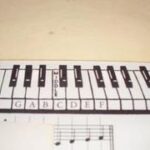Most people can sing the basic scale – doh, ray, me, fah, soh, la, te, doh. When you read music, you relate this and many other sound patterns to a system of written notes.
Notes are written on or between the lines of the treble and base staves, each pitch having its own position on the keyboard. Each has a letter name from A to G. Starting on any letter, repeated patterns of eight run alphabetically.
Bottom A is in the first space of the bass stave; B is on the first line and so forth to A on the top bass line. Middle C is suspended on a short line below the treble stave or just above the bass stave.
We tend to sing notes in a sweet ‘major’ sequence or key. But they can also be sung in ‘minor’ keys which give a mournful evocative sound, often used for sadder passages of music.
Sharps and flats The interval between two successive notes is either a tone or a semitone.
A sharp sign in front of a note raises the pitch a semitone. A flat sign lowers it by a semitone: a natural restores it to its original pitch.
All scales except C major include at least one note that has to be flattened or sharpened to preserve correct sound pattern. Because the key of a piece is always related to a scale, it will include the scale’s sharps and flats. Instead of these being shown each time they occur, they are indicated in the key signature, at the start of the passage. Flats and sharps that occur outside the key are called accidentals.
Note values Notes are sung or played at different lengths or time values and this is shown by the way they are written.
The longest normally used is an open not called a semi-breve. The minim is half its length. The crotchet, a filled note with a tail, is half the minim’s length. A quaver, a filled note with a tail and a tick or beamed to other notes is half the length of the crotchet. Subsequently shorter notes are indicated by the number if ticks or parallel beams.
Each note has its corresponding ‘rest’ sign which is written to mark a break in the music for that exact space of time.
A note or rest can be lengthened by one half of its time value by adding a dot. A note can also be ‘tied’ – coupled to a following note which is not sounded but which extends the length of the first note by its own time value.
Time The rhythm of a piece of music depends on which notes are accented. This usually falls into a pattern, marked by a regular number of beats in a bar. To show where these divisions come, a vertical bar-line is placed across the stave. A double-bar indicates the end of a passage.
The number of beats in a bar is shown numerically by the time signature. The bottom figure shows what length of note is the basic unit – a figure 2 denotes a minim, a 4 a crotchet, an 8 a quaver and so on. The top figure tells you how many units are in a bar.
A more general description of the speed and style of a passage is shown by a musical term, often in Italian, written above the stave.
Passages may also be marked specifically with, for instance ‘p'(piano) meaning soft or ‘f’ (forte) meaning loud or marked for a crescendo (increasing sound) or diminuendo (dying away).
Chords, one base note combined with related notes, played or sung together, add to the strength and richness of music. In a choir, different voices will take different notes of the chord.





